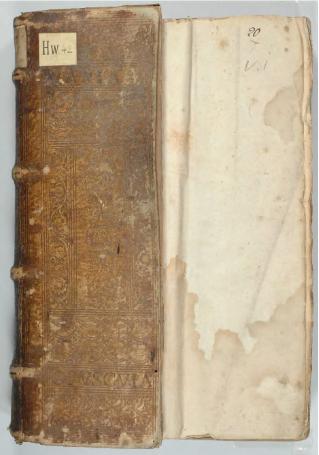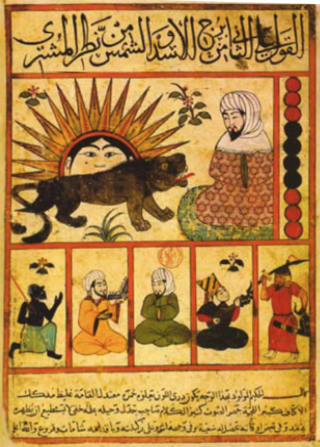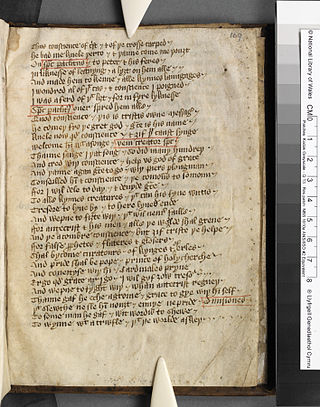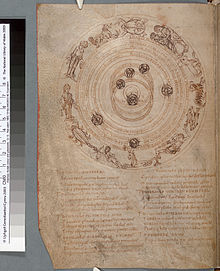
Claudius Ptolemy was an Alexandrian mathematician, astronomer, astrologer, geographer, and music theorist, who wrote about a dozen scientific treatises, three of which were of importance to later Byzantine, Islamic, and Western European science. The first is the astronomical treatise now known as the Almagest, although it was originally entitled the Mathēmatikē Syntaxis or Mathematical Treatise, and later known as The Greatest Treatise. The second is the Geography, which is a thorough discussion on maps and the geographic knowledge of the Greco-Roman world. The third is the astrological treatise in which he attempted to adapt horoscopic astrology to the Aristotelian natural philosophy of his day. This is sometimes known as the Apotelesmatika but more commonly known as the Tetrábiblos, from the Koine Greek meaning "Four Books", or by its Latin equivalent Quadripartite.
Asser was a Welsh monk from St David's, Dyfed, who became Bishop of Sherborne in the 890s. About 885 he was asked by Alfred the Great to leave St David's and join the circle of learned men whom Alfred was recruiting for his court. After spending a year at Caerwent because of illness, Asser accepted.

John Peckham was a Franciscan friar and Archbishop of Canterbury in the years 1279–1292.

The Almagest is a 2nd-century mathematical and astronomical treatise on the apparent motions of the stars and planetary paths, written by Claudius Ptolemy in Koine Greek. One of the most influential scientific texts in history, it canonized a geocentric model of the Universe that was accepted for more than 1,200 years from its origin in Hellenistic Alexandria, in the medieval Byzantine and Islamic worlds, and in Western Europe through the Middle Ages and early Renaissance until Copernicus. It is also a key source of information about ancient Greek astronomy.
Macrobius Ambrosius Theodosius, usually referred to as Macrobius, was a Roman provincial who lived during the early fifth century, during late antiquity, the period of time corresponding to the Later Roman Empire, and when Latin was as widespread as Greek among the elite. He is primarily known for his writings, which include the widely copied and read Commentarii in Somnium Scipionis about Somnium Scipionis, which was one of the most important sources for Neoplatonism in the Latin West during the Middle Ages; the Saturnalia, a compendium of ancient Roman religious and antiquarian lore; and De differentiis et societatibus graeci latinique verbi, which is now lost. He is the basis for the protagonist Manlius in Iain Pears' book The Dream of Scipio.

The National Library of Wales, Aberystwyth, is the national legal deposit library of Wales and is one of the Welsh Government sponsored bodies. It is the biggest library in Wales, holding over 6.5 million books and periodicals, and the largest collections of archives, portraits, maps and photographic images in Wales. The Library is also home to the national collection of Welsh manuscripts, the National Screen and Sound Archive of Wales, and the most comprehensive collection of paintings and topographical prints in Wales. As the primary research library and archive in Wales and one of the largest research libraries in the United Kingdom, the National Library is a member of Research Libraries UK (RLUK) and the Consortium of European Research Libraries (CERL).

Abu Ma'shar al-Balkhi, Latinized as Albumasar, was an early Persian Muslim astrologer, thought to be the greatest astrologer of the Abbasid court in Baghdad. While he was not a major innovator, his practical manuals for training astrologers profoundly influenced Muslim intellectual history and, through translations, that of western Europe and Byzantium.

Coedpoeth is a village and community in Wrexham County Borough, Wales. The built-up area with Minera had a population of 5,723 in the 2011 census.
De Excidio et Conquestu Britanniae is a work written in Latin by the 6th-century AD British cleric St Gildas. It is a sermon in three parts condemning the acts of Gildas' contemporaries, both secular and religious, whom he blames for the dire state of affairs in sub-Roman Britain. It is one of the most important sources for the history of Britain in the 5th and 6th centuries, as it is the only significant source for the period written by a near contemporary of the people and events described.

Bewnans Ke is a Middle Cornish play on the life of Saint Kea or Ke, who was venerated in Cornwall, Brittany and elsewhere. It was written around 1500 but survives only in an incomplete manuscript from the second half of the 16th century. The play was entirely unknown until 2000, when it was identified among the private collection of J. E. Caerwyn Williams, which had been donated to the National Library of Wales after his death the previous year. The discovery proved one of the most significant finds in the study of Cornish literature and language.
Byrhtferth was a priest and monk who lived at Ramsey Abbey in Huntingdonshire in England. He had a deep impact on the intellectual life of later Anglo-Saxon England and wrote many computistic, hagiographic, and historical works. He was a leading man of science and best known as the author of many different works. His Manual (Enchiridion), a scientific textbook, is Byrhtferth's best known work.

The Pwllheli and Llanbedrog Tramway was a 3 ft narrow gauge horse tramway on the coast of the Llŷn Peninsula in North West Wales, UK. It was originally constructed to convey building stone from Carreg-y-Defaid to Pwllheli's West End, with a second element to run between Pwllheli town centre and the West End resort on the seafront. The two were later connected, and extended to Llanbedrog in July 1897. The tramway was one of many developed by Solomon Andrews.
Caradoc of Llancarfan was a Welsh cleric and author associated with Llancarfan in Wales in the 12th century. He is generally seen as the author of a Life of Gildas and a Life of Saint Cadog, in Latin.
Thomas Lloyd was a Welsh cleric and lexicographer. He was the son of Thomas Lloyd, a lawyer from Wrexham and part of the Lloyd family of Llanfair Talhaearn, Denbighshire. He was educated at Jesus College, Oxford, matriculating on 25 February 1689 at the age of 15. He obtained a Bachelor of Arts degree in 1692 and his Master of Arts degree in 1695. He was ordained and was a curate in the Wrexham area, tutoring also at Chirk Castle. He was chaplain to Mary Myddelton of Croesnewydd, and lived at Plas Power which she owned. She bequeathed the property to him but he died before he inherited. He was buried in Wrexham on 22 October 1734.
Sadyrnfyw or Sadwrnfen the Generous was a bishop of Meneva in medieval Wales.
Clement of Llanthony was an Anglo-Norman clergyman and theologian who became prior of Llanthony Priory. Clement became a canon at Llanthony at a young age, and was educated there. Having held the office of sub-prior, he became prior around 1150, and died sometime after 1167, although the year is not known.

NLW MS 733B Piers Plowman is a version of the Middle English allegorical poem that combines text from versions 'A' and 'C'. It has been suggested that this manuscript, which dates from the first quarter of the fifteenth century, could help to track the evolution of the Piers Plowman poem.
Paul Panton was a Welsh barrister and antiquarian. He was known also as a reforming farmer and collector, as well as for his knowledge of Welsh history.
Thomas Wiliems was a Welsh-language antiquarian.









